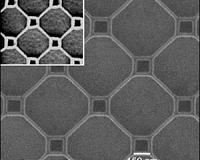 |
Evanston IL (SPX) Jun 15, 2010 Graphene oxide, a single-atomic-layered material made by reacting graphite powders with strong oxidizing agents, has attracted a lot of interest from scientists because of its ability to easily convert to graphene - a hotly studied material that scientists believe could be used to produce low-cost carbon-based transparent and flexible electronics. But to Jiaxing Huang, assistant professor of materials science and engineering, and his research group at the McCormick School of Engineering and Applied Science at Northwestern University, graphene oxide itself is even more interesting. Huang and his group have studied the material for years and have discovered how to assemble these soft sheets like floating water lilies pads. They also used a camera flash to turn them into graphene, and invented a fluorescence quenching technique to make them visible under microscopes. Now, working with Kenneth R. Shull, professor of materials science and engineering, they have discovered that graphene oxide sheets behave like surfactants, the chemicals in soap and shampoo that make stains disperse in water. The team's results are published online in the Journal of the American Chemical Society. Graphene oxide has been known in the scientific world for more than a century and was largely described as hydrophilic, or attracted to water. But Huang and his research group thought that graphene oxide should be amphiphilic, a property of surfactants that can both attracts and repels water, because part of the graphene oxide structure is actually water repelling. "We view graphene oxide as a soft material," Huang says. "For example, it is essentially two-dimensional polymers composed of carbon, hydrogen and oxygen. They are also colloidal particles with very exotic shapes." To test their hypothesis, Huang and his group put graphene oxide in carbonated water. They found that the sheets can hitchhike onto the rising bubbles to reach the water surface - just like a surfactant would do. Next they found that graphite oxide can disperse oil droplets in water - just like a surfactant would. This new insight into a fundamental property of the material, according to Huang, is important for understanding how graphene oxide is processed and handled. It could lead to new applications for the material. Its surfactant properties mean it could be used as a dispersing agent for insoluble materials, like carbon nanotubes. Common surfactants are non-conducting, so when used as a dispersing agent for conducting materials, they need to be removed from the material. Graphite oxide, which turns into conducting graphene through heating, would actually help conductivity. The surfactant behavior inspired another exciting discovery - that water surface can act as a filter for separating graphene oxide sheets by size. "The smaller the sheet, the more water-liking it becomes, so eventually it will sink into water," Huang says. This effect makes it easier to harvest large sheets of graphene oxide, which are more useful for graphene device fabrication. This work was funded by the National Science Foundation. In addition to Huang and Shull, the other authors of the paper include graduate students Jaemyung Kim, Laura Cote, Wa Yuan and postdoc Franklin Kim.
Share This Article With Planet Earth
Related Links McCormick School of Engineering and Applied Science Nano Technology News From SpaceMart.com Computer Chip Architecture, Technology and Manufacture
 Scientists Create Nano-Patterned Superconducting Thin Films
Scientists Create Nano-Patterned Superconducting Thin FilmsUpton NY (SPX) Jun 15, 2010 A team of scientists from Bar-Ilan University, Israel, and the U.S. Department of Energy's (DOE) Brookhaven National Laboratory has fabricated thin films patterned with large arrays of nanowires and loops that are superconducting - able to carry electric current with no resistance - when cooled below about 30 kelvin (-243 degrees Celsius). Even more interesting, the scientists showed they ... read more |
|
| The content herein, unless otherwise known to be public domain, are Copyright 1995-2010 - SpaceDaily. AFP and UPI Wire Stories are copyright Agence France-Presse and United Press International. ESA Portal Reports are copyright European Space Agency. All NASA sourced material is public domain. Additional copyrights may apply in whole or part to other bona fide parties. Advertising does not imply endorsement,agreement or approval of any opinions, statements or information provided by SpaceDaily on any Web page published or hosted by SpaceDaily. Privacy Statement |